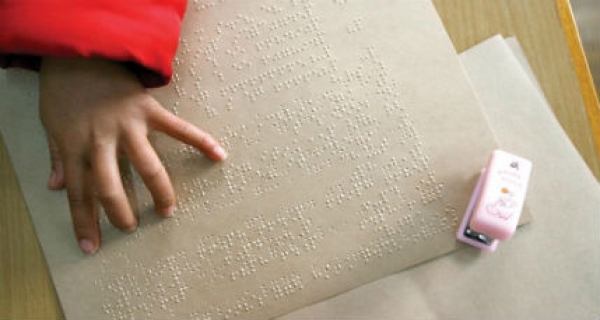Most language course work focuses on visual input as the main tool for teaching language. Students practice vocabulary by identifying pictures in the target language. Cultural curriculum focuses on the visual arts or landscapes. Exams ask students to match categories in corresponding lists.
Blind or visually impaired people benefit from language study in the same way as sighted students, but there are some key differences in the way that they learn. A multisensory approach to language teaching can help shift to a more inclusive environment.
- Classroom activities that include physical artifacts or music enable students to take in the language with their other senses.
- Descriptions of pictures in the student's original language assists with activities in which they must recognize vocabulary in the target language.
- Division of the students into groups of two or three for textbook activities can also facilitate participation, ensuring student can contribute, such as by taking notes or reporting to the class on their group's answers.
If the student excels at language, consider putting them with a group of students who are interested but struggling, so that they can trade their language skills for their peers' ability to read the print.
For situations in which the target language involves a non-Romanized writing system, teachers and students have different options:
- Use a draftsman's board or styrofoam blocks to write out important characters tactilely.
- Allow the student to use alternative systems like Pinyin, which writes out words phonetically as they sound rather than learning characters.
- Offer multiple-choice options on exams for the student to demonstrate what they have learned.
Students who need textbooks in alternative formats, such as digital, large print, or braille, sometimes don't get their materials completed on time due to factors outside their control. Language textbooks often involve fill-in-the-blank activities and photographs, which take extra time for digitalization or transcription into braille. Alternative media specialists rarely speak the target language, so they are unable to check for errors. Braille readers often don't receive their materials with the correct diacritical marks.
Developers of online resources often don't make the effort to ensure that their materials are WCAG compliant. This means that blind and visually impaired students have trouble accessing accompanying digital materials.
Teachers and language programs need to remain open to student requests for reasonable accommodations or adjustments, while understanding that changes will sometimes be made at the last minute. Keep an open mind to the creative solutions developed with the student's input and check with colleagues to see what solutions they have used. Language is an entryway into so many facets of life and the key is making sure the doors remain unlocked.







